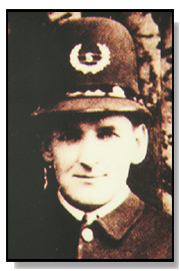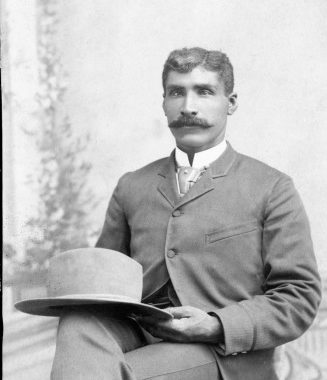Officer Del Macintyre
Biographical Info:
Born: Unknown
Age: 38
Tour of Duty: Not available
Badge Number: 5
Incident Details:
Cause of Death: Gunfire
Date of Incident: February 3, 1912
Weapon Used: Gun; Unknown type
Suspect Info: Never apprehended
Officer Del Macintyre was a “Night Watchman” for the Riverside Police Department in February of 1912. He had been a member of the department for a year and was assigned to the Arlington Station, located near a fire station at Magnolia and Roosevelt streets. (In fact, the fire station had an enclosed holding cell inside the building for police use). The City of Riverside had an on-going problem with transients in 1912, particularly in the Arlington area of the City. Officer McIntyre was aware of this fact and, according to the Riverside Daily Press, made regular rounds of the local barns, farmhouses and orange groves to guard against the “Depredations of the hobos.” On the night of February 3rd, Officer McIntyre was checking a barn at the corner of Indiana and Jefferson streets when he found a transient who had broken into the barn and was preparing to spend the night. Officer McIntyre searched the man and found he had “burglary tools”, a police billy club and a bottle of strychnine. Officer McIntyre arrested the man and walked him to the Arlington Sante Fe train depot where he locked the suspect in a box car and then made a telephone call to Police Headquarters to advise of the arrest. Officer McIntyre told the Chief what he had found and was subsequently instructed to take the “Electric car” downtown and book the suspect into the county jail. Officer McIntyre walked his suspect down Van Buren Boulevard. When they reached Canal Street, the suspect ran into the nearby orange groves. Officer McIntyre gave chase and fired warning shots at the suspect’s feet until his revolver was empty. As Officer McIntyre closed the distance between himself and his arrestee, the suspect suddenly turned and fired one shot from a .25 caliber revolver which was believed to have been hidden in the sleeve of his clothing. The bullet struck Officer McIntyre squarely in the upper body and he fell to the ground. A doctor, who lived nearby, heard the shot and found McIntyre calling for help. The doctor rendered medical aid and called other area doctors for help. A call was made to the police station as well as to the Riverside General Hospital and an ambulance was sent. All eleven Riverside Police Department officers (including the Chief) hurried to the scene of the shooting and began a vigorous search for the suspect. The Sheriff of Riverside County and his deputies broadened their search into San Bernardino County (Ontario and Chino), and later into Orange County. The Sheriff of San Bernardino and his deputies took over the river bottom search from Colton and continued further into San Bernardino County. The Riverside Chief of Police deputized fifty men and raided local stores for their guns and ammunition. Dozens of small posses searched for the suspect. One posse included the Mayor of Riverside and another one included the ex-mayor, both armed with rifles. The manhunt lasted for three days and included more than two hundred men before it was finally called off. The Riverside Police Department offered a $150 reward for the capture of the suspect, $50 of which was donated by the Riverside Police Chief (The Chief’s salary in 1912 was $125 a month). However, the suspect was never captured. It is not known why Officer McIntyre did not handcuff his prisoner or how he missed the revolver in the suspect’s sleeve during the search. On this topic, Chief of Police Coburn said, “His only fault is an inclination to be too easy with the prisoners and I believe his actions toward this thug was the cause of his being wounded. The man (suspect) was a wise fellow, whoever he is. He waited until McIntyre had emptied his gun, counting the six shots, turned on him and then shot him like he would a dog.” Officer McIntyre was taken to the Riverside General Hospital, where it was discovered that the bullet had lodged itself in the officer’s spine, causing paralysis of his lower body. The doctors believed that Officer McIntyre’s injury was fatal. He was able to give a dying declaration to the Coroner. However, McIntyre did not immediately die from his injuries. He survived and was wheelchair bound as a result of the paralysis. He lived an apparently painful life for five more years. Despite the pain and suffering, the Riverside Daily Press noted that Officer McIntyre never uttered a complaint and was well cared for by his family. Officer McIntyre passed away in July of 1917 at 38 years of age.



